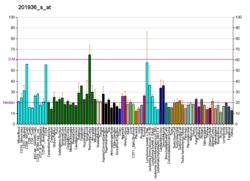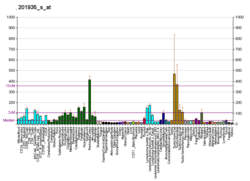EIF4G3
Eukaryotic translation initiation factor 4 gamma 3 is a protein that in humans is encoded by the EIF4G3 gene.[5][6] The gene encodes a protein that functions in translation by aiding the assembly of the ribosome onto the messenger RNA template.[7] Confusingly, this protein is usually referred to as eIF4GII, as although EIF4G3 is the third gene that is similar to eukaryotic translation initiation factor 4 gamma, the second isoform EIF4G2 is not an active translation initiation factor.[8]
Interactions
References
- 1 2 3 GRCh38: Ensembl release 89: ENSG00000075151 - Ensembl, May 2017
- 1 2 3 GRCm38: Ensembl release 89: ENSMUSG00000028760 - Ensembl, May 2017
- ↑ "Human PubMed Reference:".
- ↑ "Mouse PubMed Reference:".
- ↑ Gradi A, Imataka H, Svitkin YV, Rom E, Raught B, Morino S, Sonenberg N (Jan 1998). "A novel functional human eukaryotic translation initiation factor 4G". Mol. Cell. Biol. 18 (1): 334–42. doi:10.1128/mcb.18.1.334. PMC 121501. PMID 9418880.
- ↑ "Entrez Gene: EIF4G3 eukaryotic translation initiation factor 4 gamma, 3".
- ↑ Gingras AC, Raught B, Sonenberg N (1999). "eIF4 initiation factors: effectors of mRNA recruitment to ribosomes and regulators of translation". Annu. Rev. Biochem. 68: 913–63. doi:10.1146/annurev.biochem.68.1.913. PMID 10872469.
- ↑ Gradi A, Imataka H, Svitkin YV, Rom E, Raught B, Morino S, Sonenberg N (1998). "A novel functional human eukaryotic translation initiation factor 4G". Mol. Cell. Biol. 18 (1): 334–42. doi:10.1128/mcb.18.1.334. PMC 121501. PMID 9418880.
- ↑ Imataka H, Gradi A, Sonenberg N (Dec 1998). "A newly identified N-terminal amino acid sequence of human eIF4G binds poly(A)-binding protein and functions in poly(A)-dependent translation". EMBO J. 17 (24): 7480–9. doi:10.1093/emboj/17.24.7480. PMC 1171091. PMID 9857202.
Further reading
- Maruyama K, Sugano S (1994). "Oligo-capping: a simple method to replace the cap structure of eukaryotic mRNAs with oligoribonucleotides". Gene. 138 (1–2): 171–4. doi:10.1016/0378-1119(94)90802-8. PMID 8125298.
- Suzuki Y, Yoshitomo-Nakagawa K, Maruyama K, Suyama A, Sugano S (1997). "Construction and characterization of a full length-enriched and a 5'-end-enriched cDNA library". Gene. 200 (1–2): 149–56. doi:10.1016/S0378-1119(97)00411-3. PMID 9373149.
- Imataka H, Gradi A, Sonenberg N (1998). "A newly identified N-terminal amino acid sequence of human eIF4G binds poly(A)-binding protein and functions in poly(A)-dependent translation". EMBO J. 17 (24): 7480–9. doi:10.1093/emboj/17.24.7480. PMC 1171091. PMID 9857202.
- Pyronnet S, Imataka H, Gingras AC, Fukunaga R, Hunter T, Sonenberg N (1999). "Human eukaryotic translation initiation factor 4G (eIF4G) recruits mnk1 to phosphorylate eIF4E". EMBO J. 18 (1): 270–9. doi:10.1093/emboj/18.1.270. PMC 1171121. PMID 9878069.
- Waskiewicz AJ, Johnson JC, Penn B, Mahalingam M, Kimball SR, Cooper JA (1999). "Phosphorylation of the cap-binding protein eukaryotic translation initiation factor 4E by protein kinase Mnk1 in vivo". Mol. Cell. Biol. 19 (3): 1871–80. PMC 83980. PMID 10022874.
- Dias Neto E, Correa RG, Verjovski-Almeida S, Briones MR, Nagai MA, da Silva W, Zago MA, Bordin S, Costa FF, Goldman GH, Carvalho AF, Matsukuma A, Baia GS, Simpson DH, Brunstein A, de Oliveira PS, Bucher P, Jongeneel CV, O'Hare MJ, Soares F, Brentani RR, Reis LF, de Souza SJ, Simpson AJ (2000). "Shotgun sequencing of the human transcriptome with ORF expressed sequence tags". Proc. Natl. Acad. Sci. U.S.A. 97 (7): 3491–6. doi:10.1073/pnas.97.7.3491. PMC 16267. PMID 10737800.
- Marcotrigiano J, Lomakin IB, Sonenberg N, Pestova TV, Hellen CU, Burley SK (2001). "A conserved HEAT domain within eIF4G directs assembly of the translation initiation machinery". Mol. Cell. 7 (1): 193–203. doi:10.1016/S1097-2765(01)00167-8. PMID 11172724.
- Gradi A, Svitkin YV, Sommergruber W, Imataka H, Morino S, Skern T, Sonenberg N (2003). "Human rhinovirus 2A proteinase cleavage sites in eukaryotic initiation factors (eIF) 4GI and eIF4GII are different". J. Virol. 77 (8): 5026–9. doi:10.1128/JVI.77.8.5026-5029.2003. PMC 152112. PMID 12663812.
- Miura T, Shiratori Y, Shimma N (2003). "Backbone resonance assignment of human eukaryotic translation initiation factor 4E (eIF4E) in complex with 7-methylguanosine diphosphate (m7GDP) and a 17-amino acid peptide derived from human eIF4GII". J. Biomol. NMR. 27 (3): 279–80. doi:10.1023/A:1025442322316. PMID 12975586.
- Qin H, Raught B, Sonenberg N, Goldstein EG, Edelman AM (2003). "Phosphorylation screening identifies translational initiation factor 4GII as an intracellular target of Ca(2+)/calmodulin-dependent protein kinase I". J. Biol. Chem. 278 (49): 48570–9. doi:10.1074/jbc.M308781200. PMID 14507913.
- Gradi A, Foeger N, Strong R, Svitkin YV, Sonenberg N, Skern T, Belsham GJ (2004). "Cleavage of eukaryotic translation initiation factor 4GII within foot-and-mouth disease virus-infected cells: identification of the L-protease cleavage site in vitro". J. Virol. 78 (7): 3271–8. doi:10.1128/JVI.78.7.3271-3278.2004. PMC 371048. PMID 15016848.
- Lejeune F, Ranganathan AC, Maquat LE (2004). "eIF4G is required for the pioneer round of translation in mammalian cells". Nat. Struct. Mol. Biol. 11 (10): 992–1000. doi:10.1038/nsmb824. PMID 15361857.
- Rual JF, Venkatesan K, Hao T, Hirozane-Kishikawa T, Dricot A, Li N, Berriz GF, Gibbons FD, Dreze M, Ayivi-Guedehoussou N, Klitgord N, Simon C, Boxem M, Milstein S, Rosenberg J, Goldberg DS, Zhang LV, Wong SL, Franklin G, Li S, Albala JS, Lim J, Fraughton C, Llamosas E, Cevik S, Bex C, Lamesch P, Sikorski RS, Vandenhaute J, Zoghbi HY, Smolyar A, Bosak S, Sequerra R, Doucette-Stamm L, Cusick ME, Hill DE, Roth FP, Vidal M (2005). "Towards a proteome-scale map of the human protein-protein interaction network". Nature. 437 (7062): 1173–8. doi:10.1038/nature04209. PMID 16189514.
- Beausoleil SA, Villén J, Gerber SA, Rush J, Gygi SP (2006). "A probability-based approach for high-throughput protein phosphorylation analysis and site localization". Nat. Biotechnol. 24 (10): 1285–92. doi:10.1038/nbt1240. PMID 16964243.
- Olsen JV, Blagoev B, Gnad F, Macek B, Kumar C, Mortensen P, Mann M (2006). "Global, in vivo, and site-specific phosphorylation dynamics in signaling networks". Cell. 127 (3): 635–48. doi:10.1016/j.cell.2006.09.026. PMID 17081983.
This article is issued from
Wikipedia.
The text is licensed under Creative Commons - Attribution - Sharealike.
Additional terms may apply for the media files.







